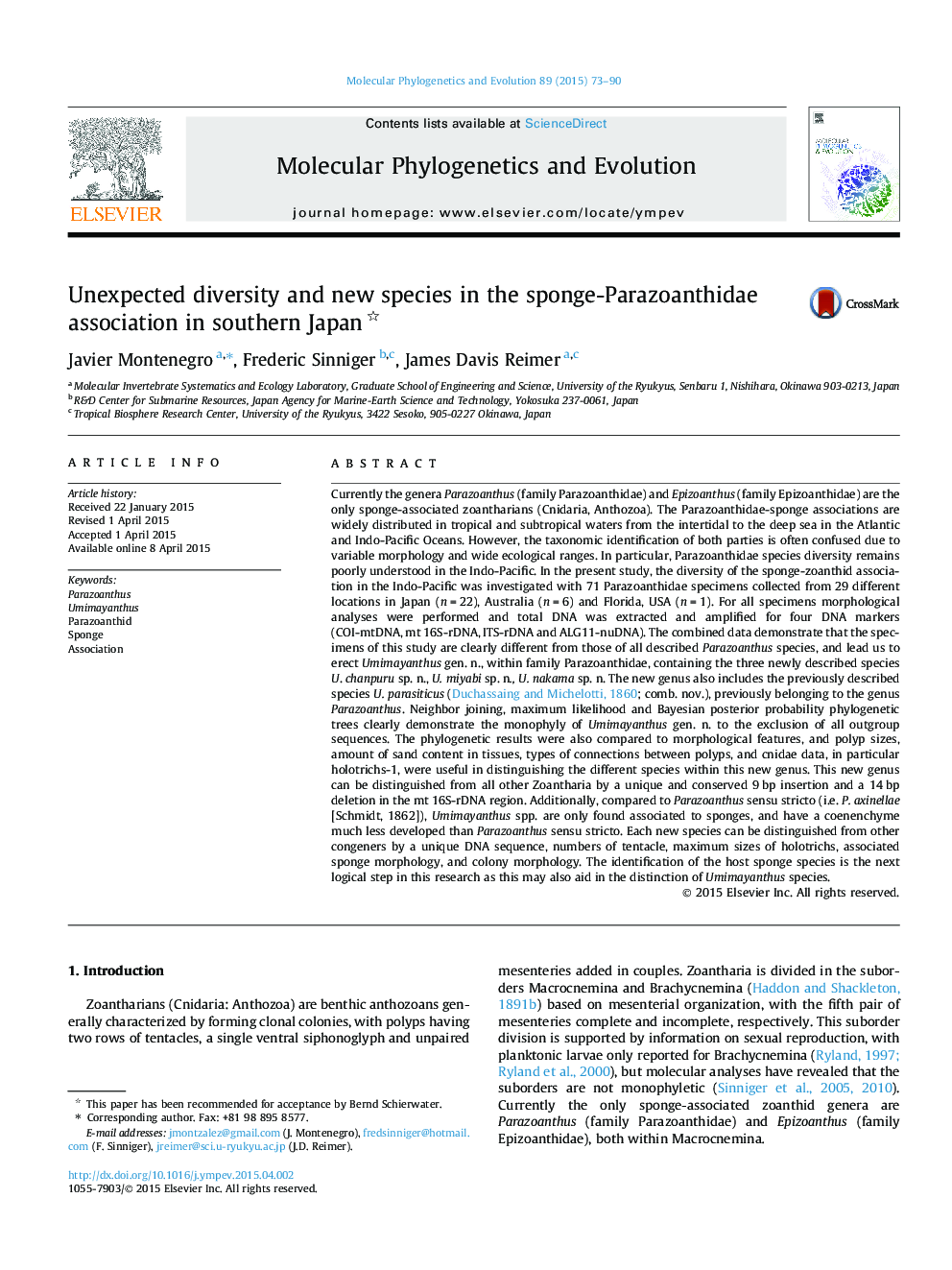| کد مقاله | کد نشریه | سال انتشار | مقاله انگلیسی | نسخه تمام متن |
|---|---|---|---|---|
| 5918885 | 1570807 | 2015 | 18 صفحه PDF | دانلود رایگان |

- The genus Parazoanthus has three distinct clades.
- All specimens in this study are different from any described Parazoanthus species.
- All specimens belong to a clade distinct from the type species of Parazoanthus.
- We erect the new genus Umimayanthus gen. n. within family Parazoanthidae.
- Umimayanthus gen. n. comprises three new species, and U. parasiticus n. comb.
Currently the genera Parazoanthus (family Parazoanthidae) and Epizoanthus (family Epizoanthidae) are the only sponge-associated zoantharians (Cnidaria, Anthozoa). The Parazoanthidae-sponge associations are widely distributed in tropical and subtropical waters from the intertidal to the deep sea in the Atlantic and Indo-Pacific Oceans. However, the taxonomic identification of both parties is often confused due to variable morphology and wide ecological ranges. In particular, Parazoanthidae species diversity remains poorly understood in the Indo-Pacific. In the present study, the diversity of the sponge-zoanthid association in the Indo-Pacific was investigated with 71 Parazoanthidae specimens collected from 29 different locations in Japan (n = 22), Australia (n = 6) and Florida, USA (n = 1). For all specimens morphological analyses were performed and total DNA was extracted and amplified for four DNA markers (COI-mtDNA, mt 16S-rDNA, ITS-rDNA and ALG11-nuDNA). The combined data demonstrate that the specimens of this study are clearly different from those of all described Parazoanthus species, and lead us to erect Umimayanthus gen. n., within family Parazoanthidae, containing the three newly described species U. chanpuru sp. n., U. miyabi sp. n., U. nakama sp. n. The new genus also includes the previously described species U. parasiticus (Duchassaing and Michelotti, 1860; comb. nov.), previously belonging to the genus Parazoanthus. Neighbor joining, maximum likelihood and Bayesian posterior probability phylogenetic trees clearly demonstrate the monophyly of Umimayanthus gen. n. to the exclusion of all outgroup sequences. The phylogenetic results were also compared to morphological features, and polyp sizes, amount of sand content in tissues, types of connections between polyps, and cnidae data, in particular holotrichs-1, were useful in distinguishing the different species within this new genus. This new genus can be distinguished from all other Zoantharia by a unique and conserved 9 bp insertion and a 14 bp deletion in the mt 16S-rDNA region. Additionally, compared to Parazoanthus sensu stricto (i.e. P. axinellae [Schmidt, 1862]), Umimayanthus spp. are only found associated to sponges, and have a coenenchyme much less developed than Parazoanthus sensu stricto. Each new species can be distinguished from other congeners by a unique DNA sequence, numbers of tentacle, maximum sizes of holotrichs, associated sponge morphology, and colony morphology. The identification of the host sponge species is the next logical step in this research as this may also aid in the distinction of Umimayanthus species.
Journal: Molecular Phylogenetics and Evolution - Volume 89, August 2015, Pages 73-90